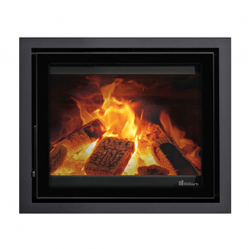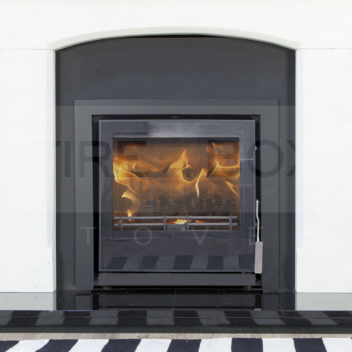Technical Details
| Product Title | Mendip Christon Inset 550 SE with 4 sided frame, 4.8kW, ECODESIGN Read |
|---|---|
| Product Keyword | Mendip Christon Inset 550 SE, 4 sided frame, 4.8kW stove, ECODESIGN Ready, Inset woodburner |
| Energy Efficiency | A |
| SIA Ecodesign Ready | Yes |
| Output (Nominal) | 4.8kW |
| Output (Maximum) | 7kW |
| Smoke Control (DEFRA) | Yes |
| Boiler Stove | No |
| Colour | Black |
| Flue Outlet Size | 125mm - 5in |
| Fuel | Multifuel |
| Height | 550mm |
| Width | 550mm |
| Depth | 360mm |
| Nominal Output (Range) | 3kW - 5kW |
| Width (Range) | 500mm - 600mm |
| Nett Efficiency (%) | 77.8 |
| Max log length | 400mm |
| Distance to Combustibles (Side) | 200mm |
| Distance to Combustibles (Rear) | 200mm |
| Style | Modern / Contemporary |
| Centre of Flue to Rear | 105mm |
| Distance to Combustibles (Top) | 375 |
| Direct Air Kit Available | Yes |
| Convector or Radiant | Convector |
| Height (Range) | 500mm - 600mm |
Product Description
Mendip Christon Inset 550 SE with 4-Sided Frame
Product Description
The Mendip Christon Inset 550 SE is a contemporary and stylish inset wood burning stove that offers a blend of modern design and eco-friendly combustion. Designed to fit seamlessly into a variety of interior spaces, this 4.8kW heat output stove meets the rigorous ECODESIGN standards, ensuring reduced emissions and higher efficiency. The inclusion of a 4-sided frame provides a clean and integrated look perfect for any modern living space.
Key Features
- Heat Output: 4.8kW – ideal for small to medium-sized rooms
- ECODESIGN Ready: Meets the latest standards for efficiency and emissions
- 4-Sided Frame: Provides a sleek, built-in appearance
- Contemporary Design: Fits seamlessly into any modern interior
- Inset Installation: Designed to be built into the wall for a minimalist look
- Clean Burn System: Ensures maximum combustion efficiency and minimal waste
- Airwash System: Keeps the glass door clear for an unobstructed view of the flames
- Constructed from High-Quality Materials: Ensures durability and long-lasting performance
- Easy to Operate: User-friendly controls for a hassle-free experience
File Downloads
Reviews
Inset Stoves > Multifuel Eco Design Inset Stoves

Multifuel Inset Stoves
Here we have displayed our large range of multifuel inset stoves, perfect for areas where floor space is limited and a freestanding multifuel stove is not an option. Our multifuel inset stoves are designed to burn wood, coal or smokeless fuels providing greater flexibility on fuel types available and come in different outputs, including 3kW multifuel inset stoves up to 10kW and over multifuel inset stoves.
Our extensive range of multifuel inset stoves are available in contemporary or traditional designs, many of which come with a choice of frame sizes and finishes, to allow you to customise the stove to match your interior décor. Whatever type of multifuel inset stove you are looking for and no matter what your budget is, pop into one of our showrooms or give us a ring to discuss all the options available to you and get advice from our expert team.




